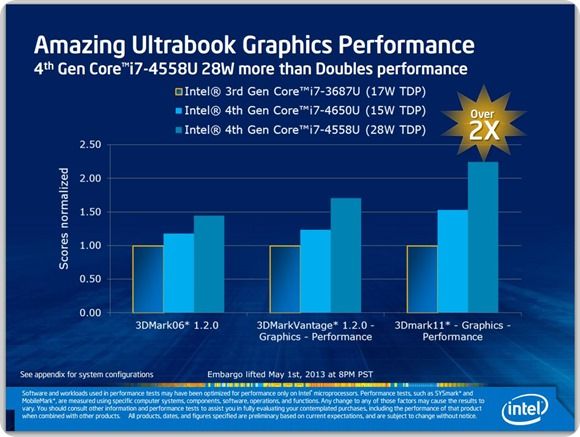Intel Iris and Intel Iris Pro have just been announced as the new brands for the top two tiers of Intel’s 4th-gen Core processor (Haswell) graphics. Iris will appear in Ultrabooks but, surprisingly, only on a 28W TDP processor. It indicates that there are some higher-level processing options coming to Ultrabooks. Other 4th-gen Core processors for Ultrabooks get HD 5000 graphics.
Intel have just announced Iris and Iris Pro, HD 5100 and HD 5200 integrated GPUs for 4th-Gen Core processors (Haswell.) The Intel Iris Graphics (HD 5100) will appear in a 28W version of a Core 4xxx processor for Ultrabooks. The Core i7-4558U will be one of those processors.
Information sent to us shows a 2X improvement in 3DMark11 graphics performance.
- 2X 3D performance increase over Intel HD Graphics for the high performing U-series processors
designed specifically for Ultrabooks, with Intel Iris graphics
Performance figures show 2X improvement for 28W TDP Core i7-4558U but not the more efficient 15W TDP Core i7-4650U which shows only 50% improvement according to Intel figures. This is not surprising considering the lower power figure and note that we’re expecting even lower TDP processors for Ultrabooks too so there’s a range of graphics capabilities to be considered for the next round of Ultrabooks starting in June.
The information given confirms a Core i7-4650U at 15W TDP with an expected 50% performance increase with 3DMark11 over a Core i7-3687U (17W TDP) so you can expect more 3D performance along with more Intel Quick Sync video encoding/decoding performance for less power utilization. It’s one of the key figures that will interest efficiency fans looking for longer battery life, quieter fans and more power.
Anandtech previously measured a 3DMark11 score of 648 with a Core i5 3rd-Gen processor [link]. Laptopmag measured 670 with Core i7-3517U 3rd-gen processor [link] and together it indicates a score of around 1000 for the 4th-gen 15W TDP Core. There’s less of a percentage improvement in 3DMark06 scores. No figures were given for Quick Sync video encoding improvements but we’re expecting 1.5-2X improvement there. For those upgrading from an older laptop, the performance increase could be very significant. Intel sent this information:
If you compare to the installed base, consumers upgrading a four year old notebook with an Intel® Core™2 Duo processor to a new Ultrabook with a 4th Gen Intel Core i5 4200U processor with Intel Iris graphics will experience a significantly better computing experience3:
- Almost half as thin and half the weight
- 17X faster video conversion (optimize a video for a social media site)
- 25X faster graphics performance (playing visually rich, mainstream PC games)
Our Haswell processing and graphics feature overview is here.
Souce: Intel.












“Iris” – is this a new brand name for their GPU core or just a codename?
Brand name
28W? I wonder what kind of battery life ultrabooks would get with that seeing that batteries aren’t getting more efficient or bigger in these things.
28W is only the max figure. There shouldn’t be too much penalty unless you really need the power. My guess is that it’s a quad core though because Iris itself isn’t going to add so much to the TDP. It’s an interesting conundrum.
Don’t quad cores have a Q somewhere in their SKU?
I wonder what the average power will be between the 17 W and 28 W chips. Doesn’t Intel have SDP now for a more typical type of power dissipation requirement or are those restricted to the Y designated chips?
Yea, its a dual core. It’s the Iris part that adds to the TDP. That means the CPU part should perform better when its the only one running, but most of the TDP increase is to accomodate for the faster GPU.
Really? A 25% GPU performance increase over the 15W TDP HD 5000 part costs nearly double the TDP? I don’t believe it unless they’ve unlocked some viery high Turbo Clock.
Actually that’s a 50% gain, for 3DMark11.
You’d need more than 50% clock increases to get 50% gain in performance, and voltage increases on top of clock would easily get it that much higher.
The benefit is for Ultrabooks in the 14/15 inch that would otherwise feature discrete graphics. It’s not just thermal benefits, but having it in single chip rather than CPU + GPU + GPU memory is a space benefit.
If the 15w can do 150% over the IVB and the 28W does 200% then it’s something like 33% improvement in graphics between the two new shown processors. I think. But anyway, maybe you’re right DavidC1 and maybe there’s at more to it than just the GPU. I’ll be keeping a close eye on this.
If that’s true then the performance increase is overshadowed by that large jump in TDP. Then again I don’t know the TDP of a comparable mobile discrete GPU.
OMG a 28W CPU?!? That is either going to have TERRIBLE battery life or be a big, giant fatty laptop that probably shouldn’t be called an Ultrabook.
Laptop? -Sound more like a “wholebodytop”. I don’t think I’d want a 28W cpu containing laptop to fall on me from a high shelf…
Adam
It’s supposedly for 14″+ ultrabooks where a discrete GPU may be replaced by the Iris GPU instead. At least that’s what AnandTech says.
Aren’t there existing ultrabooks with discrete GPUs that probably have a higher TDP (CPU + GPU) than this? Also, are all (some?) Haswell chips SoCs which integrate more functionality into the chip and thus lowering overall power consumption?
Only the U series chips are 1-chip, which is what the 28W and 15W chips are.
It actually says 1.5x for the 15W and 2.25x for the 28W. That means the 28W is an additional 50% faster.
The difference is mostly due to GPU clocks and the corresponding voltage increase that comes with it. Getting a faster CPU is just a side benefit of having a 28W TDP headroom.